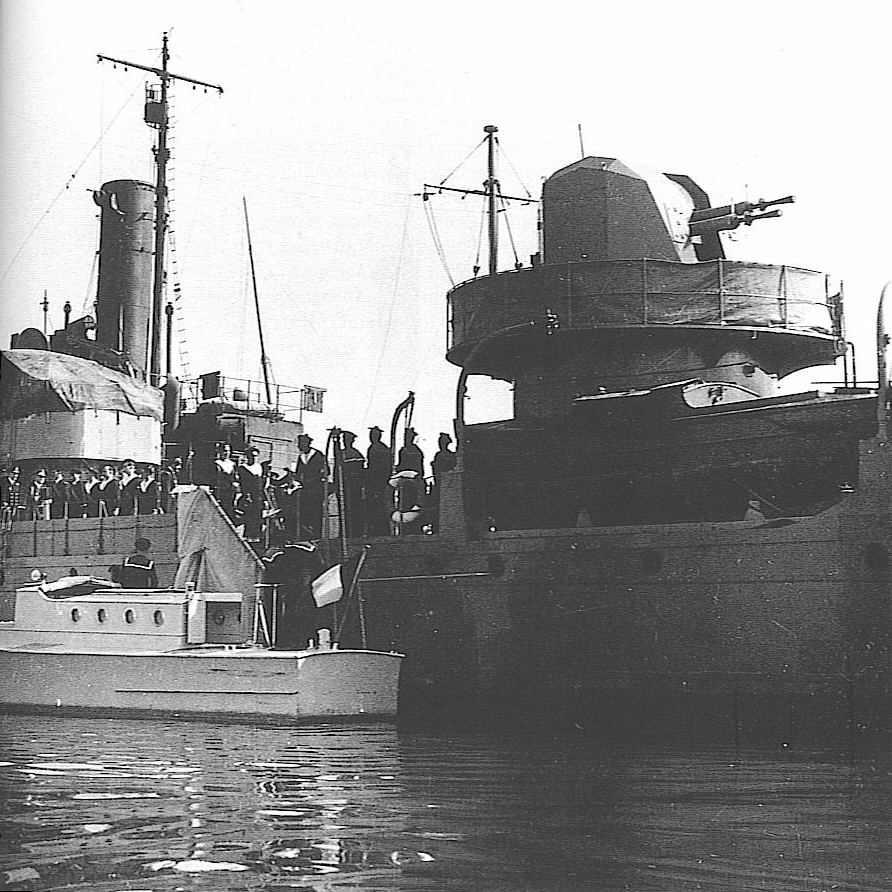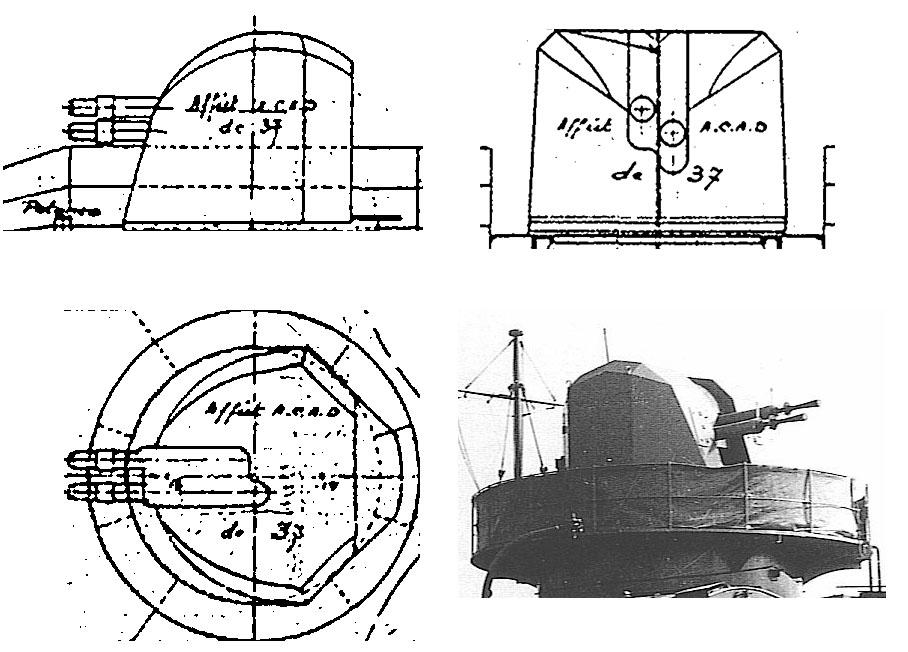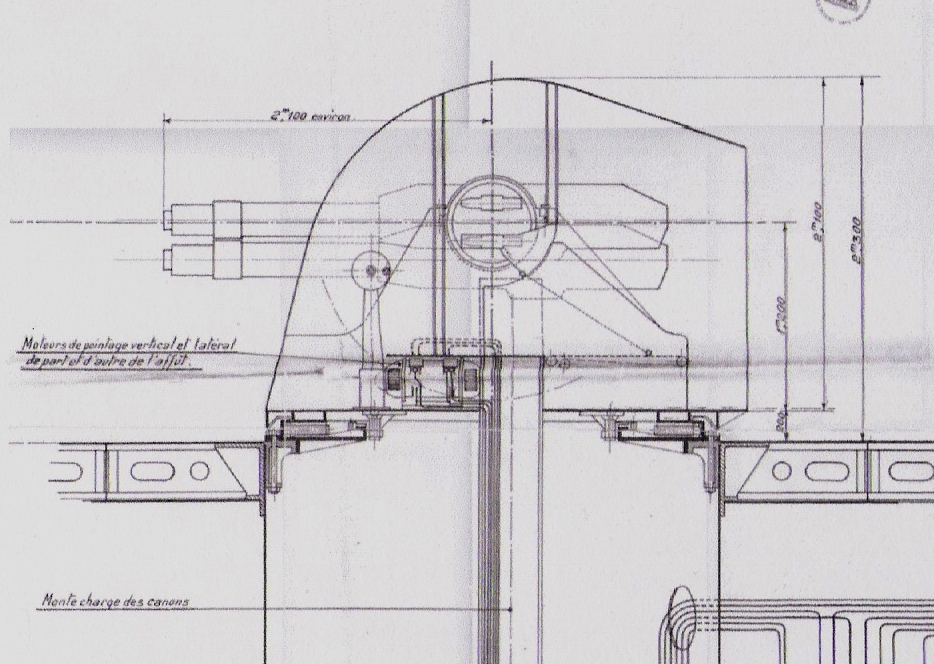
Recognizing that the semi-automatic 37 mm Model 1933 AA gun was not an effective weapon, the French started work on a much improved fully automatic 37 mm gun which was designed by the Artillerie Navale at Ruelle. However, this weapon did not finish development before the French surrender in 1940. One of the few prototypes was mounted on the old Patrol Sloop Amiens and was apparently successfully used during the Dunkirk evacuation.
Each gun had a pusher hoist for the six-round magazines. A remote director with a 2-meter rangefinder was used for RPC together with Sautter-Harlé electric servo-motors. However, the guns were controlled only in train, elevation was still manually operated. For some ships, including the battleship Richelieu, it was planned that each director would control two twin mounts.
A Note on Sources: In "Naval Weapons of World War Two" this gun is described as being 48 calibers long. However, Official Artillerie Navale documents show that the gun was actually 70 calibers long.
There was one further 37 mm gun that was under consideration at the time the war started, the 37 mm zénithaux (zenith). This was a Hotchkiss design for a quadruple mounting intended for use against dive bombers. This mounting was unusual in that its platform was tilted at an angle to facilitate high-angle firing and as a result the guns could not depress past +45 degrees. The mounting would have been countersunk in the deck and loaded from beneath, similar in concept to the British BD (Between Deck) designs. The surrender of France in 1940 halted development and this weapon never made it off the drawing board.
Unless otherwise noted, the data that follows is for the 37 mm Model 1935.
| Designation | 37 mm/70 (1.46") AA Gun Model 1935 |
|---|---|
| Ship Class Used On | Patrol Sloop Amiens (Prototype)
Planned for Battleships, Cruisers and Destroyers of the late 1930s-1940s |
| Date Of Design | 1933 |
| Date In Service | 1936 |
| Gun Weight | 3,200 lbs. (1,450 kg) |
| Gun Length oa | N/A |
| Bore Length | N/A |
| Rifling Length | N/A |
| Grooves | N/A |
| Lands | N/A |
| Twist | N/A |
| Chamber Volume | N/A |
| Rate Of Fire 1 | Cyclic: 165 - 172 rounds per minute
Practical: N/A (I would guess about 60 - 100 due to barrel life considerations) |
- ^Very high rates of fire were achieved with the single gun prototype. In early trials at Sevran, several bursts of 100 rounds were fired in under 36 seconds at zero elevation. Bursts of 150 to 170 rounds were fired at angles between zero and 70 degrees of elevation, including one continuous burst of 142 rounds. However, such high firing rates wore out the barrels in just a few minutes. See ammunition section below.
| Type | Fixed |
|---|---|
| Weight of Complete Round | N/A |
| Projectile Types and Weights | HE - 1.80 lbs. (0.816 kg) |
| Bursting Charge | 1.76 oz (50 g) HMn |
| Projectile Length | N/A |
| Propellant Charge | 0.46 lbs. (0.21 kg) "special Hotchkiss" |
| Muzzle Velocity | 2,707 fps (825 mps) |
| Working Pressure | 19.0 tons/in2 (3,000 kg/cm2) |
| Approximate Barrel Life 1a | 600 rounds |
| Ammunition stowage per gun | N/A |
- ^As mentioned above, barrel life was very short with these weapons due to the high working pressures and the figure given above was the best that was achieved after intensive efforts with metallurgy. The long development cycle for these weapons was mainly related to efforts to increase life. Water-cooling was under investigation at the time of the French surrender. The following is taken from a translated report on the results of comparison trials with Schneider 37 mm guns:
"Trials are in progress to determine the choice of metal which will minimize barrel wear while resisting the premature explosion of a shell in the breech. It will probably prove difficult to increase the maximum number of rounds per minute which can be fired before the barrel needs replacement. For the [ACAD Mle 1935] gun designed by Artillerie Navale, this will be around 600 rounds; for the Schneider gun which obtains slightly greater power with a shorter barrel (45 calibers vs. 70 [for the AN gun]) the figure would be ca. 400 rounds - which corresponds to about 2 minutes of continuous fire."
| Elevation | Distance |
|---|---|
| Maximum Range @ 45 degrees | 8,750 yards (8,000 m) |
| Designation | Twin Mount Prototype: ACAD Mle 1936 1b 2b |
|---|---|
| Weight | Twin Mount: 17,800 lbs. (8,070 kg) |
| Elevation | -10 / +85 degrees |
| Elevation Rate | Manually operated, only |
| Train | 360 degrees |
| Train Rate | N/A |
| Gun recoil | N/A |
- ^The Model 1936 was a base ring type and the hoists rotated with the gunhouse. There was a working chamber or ammunition lobby under the mounting from which twin continuous belt hoists rose to the guns. Crewmen in the working chamber took magazine boxes stored in ready racks and fed them into the hoists. The hoists raised the magazine boxes to the floor of the gunhouse near the trunnions. The loaders pulled the magazine boxes from the hoists and inserted them horizontally into a continuous feed mechanism which was located at the trunnion axis (see sketch below). Empty boxes were automatically ejected to the rear and slid out of the mounting on inclined chutes.
- ^Besides the twin mounting, a quad mounting was also planned.


"Naval Weapons of World War Two" by John Campbell
"Battleships: Allied Battleships in World War II" by W.H. Garzke, Jr. and R.O. Dulin, Jr.
"French Battleships: 1922 - 1956" by John Jordan and Robert Dumas
"Navies of the Second World War - The French Navy" by Henri le Masson
---
Special help from John Jordan
22 May 2008 - Benchmark
14 December 2009 - Added information on ROF, mounting, RPC arrangements, barrel life and zénithaux design
12 January 2016 - Additional information supplied courtesy of John Jordan
29 December 2016 - Added link to Tony William's website
16 February 2018 - Converted to HTML 5 format
10 June 2023 - Fixed broken link to point at Wayback Archives
